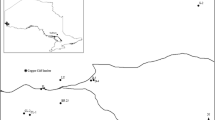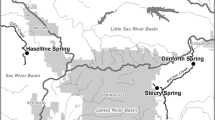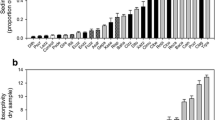Abstract
Community respiration and net primary productivity measurements from precleaned and disturbed substrates of various sizes were collected to examine the colonization and recovery rates of lotic epilithic communities in situ. The assumptions and limitations of the technique for monitoring metabolic recovery are discussed. The results indicate that substrate size and heterogeneity affect the rates of metabolic recovery; metabolic recovery of the heterotrophic community component generally occurs before the autotrophic; following a physical disturbance 13–21 days are required for metabolic recovery while pre-cleaned mixed and homogenous large sized substrates require 15–21 days; a temporary summer metabolic equilibrium appears to exist in the Sheep River, the duration of which is dependent on abiotic environmental variables. Future metabolic studies should include structure and composition measurements to attain maximum information on the recovery of epilithic communities.
Similar content being viewed by others
References
Cummins, K. S., 1973. Trophic relations of aquatic insects. Ann. Rev. Ent. 18: 183–205.
Floodgate, G. D., 1972. The mechanism of bacterial attachment to detritus in aquatic systems. Mem. 1st. ital. Idrobiol. 29: 309–323.
Gore, J. A., 1979. Patterns of initial benthic recolonization of a reclaimed coal strip-mined river channel. Can. J. Zool. 57: 2429–2439.
Hansson, L., 1977. Spatial dynamics of field vole Microtus arestis in heterogenous landscapes. Oikos 29: 539–544.
Hargrave, B. T. & Phillips, G. A., 1977. Oxygen uptake and microbial communities on solid surfaces. In: Cairns, J. (ed.) Aquatic Microbial Communities. Garland Publ., New York: 545–587.
Hart, D. D., 1978. Diversity in stream insects: regulation by rock size and microspatial complexity. Verb. int. Ver. Limnol. 20: 1376–1381.
Horner, R. R. & Welch, E. B., 1981. Stream periphyton development in relation to current velocity and nutrients. Can. J. Fish. aquat. Sci. 88: 449–457.
MacArthur, R. H. & Wilson, E. O., 1967. The Theory of Island Biogeography. Princeton University Press, Princeton, N. J. 203 pp.
Marshall, K. C., Stout, R. & Mitchell, R., 1971. Mechanism of the initial events in sorption of marine bacterial to surfaces. J. gen. Microbial. 68: 337–348.
Moore, R. L., Osborne, L. L. & Davies, R. W., 1980. The mutagenic activity in a section of the Sheep River, Alberta receiving a chlorinated sewage effluent. Wat. Res. 14: 917–920.
Naiman, R. J. & Sedell, J. R., 1980. Relationship between metabolic parameters and stream order in Oregon. Can. J. Fish. aquat. Sci. 37: 834–847.
Osborne, L. L., 1981. Effects of Chlorine on the Benthic Communities of the Sheep River, Alberta. Ph.D. thesis, University of Calgary, Calgary, Alberta, Canada. 536 pp.
Osborne, L. L. & Davies, R. W., 1981. A device to measure in situ lotic benthic metabolism. Hydrobiologia 79: 261–264.
Osborne, L. L., Iredale, D. R., Wrona, F. J. & Davies, R. W., 1981. Effects of chlorinated sewage effluent on fish in the Sheep River, Alberta. Trans. am. Fish. Soc. 110: 536–540.
Pennak, R. W. & Van Gerpen, E. D., 1947. Bottom fauna production and physical nature of the substrate in a northern Colorado trout stream. Ecology 28: 42–48.
Pianka, E. R., 1978. Evolutionary Ecology, 2nd ed., Harper & Rowe, New York. 356 pp.
Smith, M. H., Manlove, M. N. & Joule, J., 1978. Spatial and temporal dynamics of the genetic organization of small mammal populations. In: Snyder, D. P. (ed.) Populations of Small Mammals Under Natural Conditions, Pymatuning Symp. in Ecology 5: 99–113.
Stenseth, N. C., 1980. Spatial heterogeneity and population stability: Some evolutionary consequences. Oikos 35: 165–184.
Tarzwell, C. M., 1936. Experimental evidence on the value of trout stream improvement in Michigan. Trans. am. Fish. Soc. 66: 177–187.
Vannote, R. L., Minshall, G. W., Cummins, K. W., Sedell, J. R., & Cushing, C. E., 1980. The river continuum concept. Can. J. Fish. aquat. Sci. 37: 130–137.
Vollenweider, R. A., 1969. A Manual on Methods for Measuring Primary Production in Aquatic Environments. Int. Biol. Prog., Handbook 12. Blackwell Scientific Publishers, Oxford, 213 pp.
Ward, J. V., 1975. Bottom fauna substrate relationships in a northern Colorado trout stream: 1945 and 1974. Ecology 56: 1429–1434.
Zillich, J. A., 1967. Response of lotic insects to artificial substrate samples. M.Sc. thesis, University of Wisconsin, Madison. 123 pp.
Author information
Authors and Affiliations
Rights and permissions
About this article
Cite this article
Osborne, L.L. Colonization and recovery of lotic epilithic communities: A metabolic approach. Hydrobiologia 99, 29–36 (1983). https://doi.org/10.1007/BF00013715
Received:
Revised:
Accepted:
Issue Date:
DOI: https://doi.org/10.1007/BF00013715




